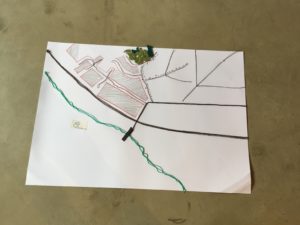A journey to Fondazione Pistoletto at the discovery of demopraxy: the workshop of demopractic mapping was held from Sunday 13th to Wednesday 16th May, with the participation of a delegation from Alghero composed of volunteers, researchers and students from the Deca Master course in Law of DADU – Department of Architecture, Design and Urban Planning, and the Fine Arts Academy “Mario Sironi” in Sassari. The four-day event was the result of a collaboration between Cittadellarte and the referent of the initiative Maria Gabriella Lay, representative of the UN’ International Labour Organization (ILO) and Rebirth/Third Paradise ambassadress, who took part in the activities giving her contribution.
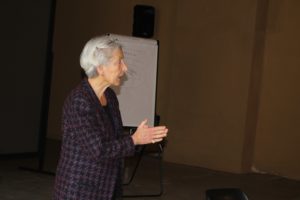

(Maria Gabriella Lay)
The beginning, the visits and the interiorist photography
On the Sunday afternoon and Monday morning the delegation was introduced to the Foundation with a visit to its spaces. After the walk through Pistoletto’s works and the areas housing the activities of Cittadellarte’s operative units, the group initiated their programme with their first activity: “Interiorist Photography”. It is a mental practice which has been organized several times by Cittadellarte (at Oasi Zegna, for example, as mentioned in one of our previous articles) and which allows the participants to turn into photographers investigating and experimenting with themselves, elaborating images that are the result of personal inclinations and experiences. The method consists in the application of an analytical-descriptive approach through which the “photographers” express their sensibility and psychological introspection skills, feeling themselves in time and space. The participants took a series of shots without concentrating on the technique, but rather on the relationship between their self and the surrounding space. The Sardinian group therefore showcased micro- and macro-spaces, and moments in Cittadellarte, each giving the photographs their personal stamp.
The Rebirth Forums and the demopraxy
After the practice of the interiorist photography, which allowed the participants to physically and mentally immerse themselves in the spaces of Cittadellarte, on Monday afternoon Paolo Naldini, director of Cittadellarte, presented to the group the peculiarities of the Third Paradise and the demopraxy. The director explained how the morning activity was a way to start expressing the relationship between one’s self and the context, a sort of prelude to the subsequent mapping exercise. He then focused on demopraxy and the demopractic mapping, illustrating the way it works and how it was born.
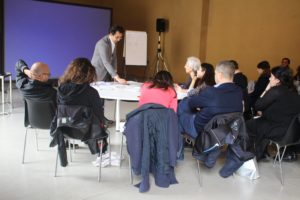
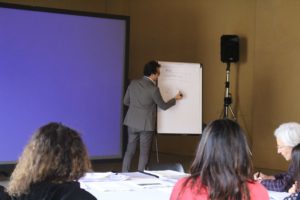
In this context, Naldini also introduced the two main points of reference for the demopractic mapping: the UN’s 17 Sustainable Development Goals and the project “Geographies of Transformation”, two key elements on which the mapping oper-actions to be activated are centred.
The group then took the necessary steps to prepare a Forum, the first being the forming of a team of mappers who identify subjects and organizations with a responsible social impact, from the service industry to businesses to universities.
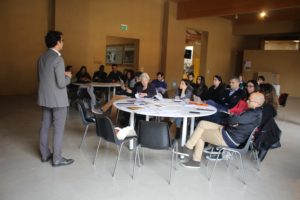

The meetings
On the Tuesday, the participants attended a series of meetings throughout the day: one with Michele Cerruti But (from Cittadellarte’s Education Office), who explained the basic elements of urban planning and mapping, eventually focusing on Cittadellarte’s urban research and in particular the Bordeaux Biennale of Urban Art; the other was with Juan Sandoval (in charge of the Art Office), who presented and made the participants play (d)estructura, which is an activity/project half way between art, play and social research in the context of social cartography, encouraging forms of horizontal sociality in a micro-dimension (please see our previous article for all the details). Juan Sandoval was also the lecturer of the seminar called “Art and the writing of the territory: from the mapping to the visual narrative – experiences and case studies”.
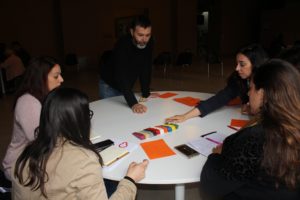

(La sessione di gioco a (d)estructura)
Special guest for the evening was Egidio Dansero, a professor from the Department of Cultures, Politics and Society of the University of Turin, who talked about a conceptual investigation of the territory analysing the different ways of considering it in building politics, and, starting from the relationship between human conglomerate and environment (space/nature), gave various definitions of territory also examining the territoriality aspect.
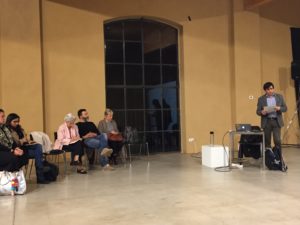
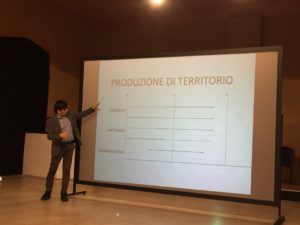
(Due immagini della conferenza di Egidio Dansero)
The mapping and the feedback
On the Wednesday, the closing day of their experience at Cittadellarte, the mapping work was presented by all the volunteers, researchers and students who, divided in four groups, had taken part in the activity exploring Biella’s Riva and Chiavazza neighbourhoods.

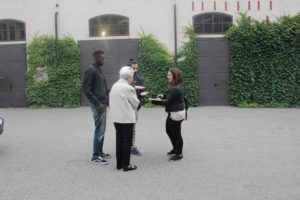
The first group dealt with the mapping of the Riva neighbourhood. The new mappers investigated the relationship between the neighbourhood and Biella’s city centre, a research carried out without the help of paper or digital maps, but rather only asking passers-by for directions to the set destination.
The group arranged on a board (see picture below) a series of images referring to the route walked, documenting through them all the “steps” taken.
“We see the territory as if made of layers, – explained the components of the group – that is past, present and future. We think that mapping the present means asking ourselves questions about the future”.
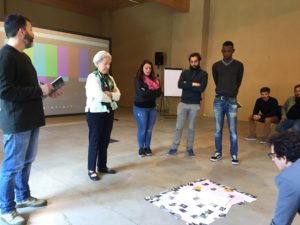
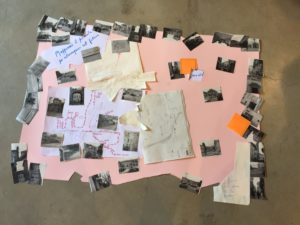
The second group focused their work on the Riva neighbourhood too, but from a different perspective. Theirs turned out to be a green investigation, with a mapping of the green areas, identifying and distinguishing the trees lining the roads. On the map is the route they followed, a representation conceived to produce a strong visual impact (in darker green are the areas with more trees, in lighter green the areas with a reduced number of trees).
“We designed an easy-to-read map – they said – recalling the veining of a leaf. Together, we have also edited a video showing 12 types of leaves from as many trees from the areas we visited, creating a particular transposition superimposing them to one another into a single image. This is how our leaf was born, the fruit of the combination of all of them”. The work of both groups clearly shows a coherence between form and content.
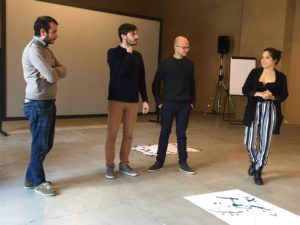

The third group, who operated in the Chiavazza neighbourhood, avoided a direct cartographic approach. The team in fact wandered without following a particular route, focusing on the local attractions and structures, and socializing with other pedestrians. They gathered in a video all the images characterizing their itinerary.
“We had a pick everywhere, – they explained – also to find places where we could recognize ourselves. We talked to people and perceived the nature of the places we visited”. Their mapping includes a representation of the Third Paradise. Why is that? “We think that Michelangelo Pistoletto’s sign-symbol is perfect to tie together our experiences throughout the days”, they replied.
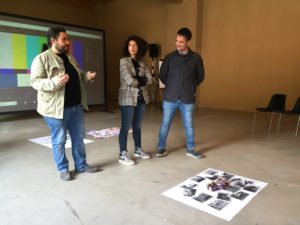
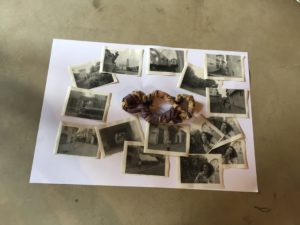
The fourth group also focused on Chiavazza: “We have highlighted elements relevant to the representation of the area”, they said. Their mapping shows an unscientific experiential trait giving prominence to barriers and gates. “While we were walking – they continued – our passage was often blocked by gates and barriers, which prevent pedestrians from entering and looking at the space beyond. We have also noticed that the walls are not graffitied, and the only artistic and expressive manifestations are on wipe-clean and residual surfaces”. Their mapping includes photographs of the physical barriers and writings encountered along the way.

